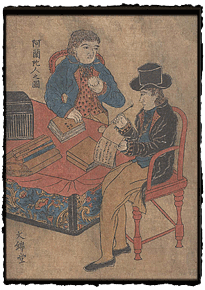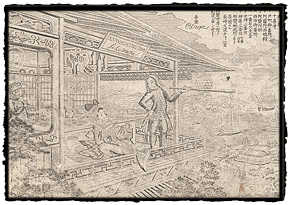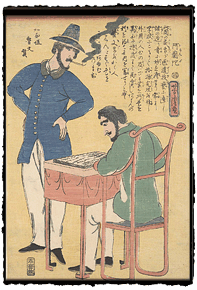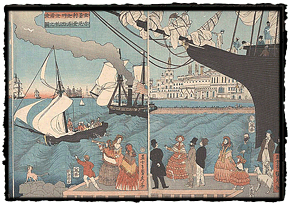Foreigners and Disease
Page 2 of 2
 The collection also includes two rare prints depicting the foreign residents of
Nagasaki. The first, an anonymous print dating to ca. 1800, features a pair of Dutch
gentlemen seated at a cloth-covered table, which appears to be a sea chest in
disguise. The artist records with precision the novel appearance of these foreign men:
the black topcoat and ruffled jabot, wavy hair curling under a tall hat, the long, straight
nose. The collection also includes two rare prints depicting the foreign residents of
Nagasaki. The first, an anonymous print dating to ca. 1800, features a pair of Dutch
gentlemen seated at a cloth-covered table, which appears to be a sea chest in
disguise. The artist records with precision the novel appearance of these foreign men:
the black topcoat and ruffled jabot, wavy hair curling under a tall hat, the long, straight
nose.
Seated in a wooden chair, a contrivance not found in most Japanese homes at that
time, the man writes with a quill pen (not a brush!), moving from left to right in the
Western fashion. The man opposite him holds a circular disk in one hand, with marks at
the edges like a cracker or pastry. Baked goods were as exotic as the men and their
costumes, in a culture without ovens or bread.
It is likely that in making this image of foreigners at work, the artist relied on
illustrations and engravings from the West for inspiration. Ironically, though there was
clearly a demand for images of Nagasaki's foreign residents, few artists seem to have had
the opportunity to observe them at first hand.
 A second image of Nagasaki residents, dating to the 1850s, clearly reflects this
paradoxical situation. In this case, the scene portrays two men in the company of
a Japanese woman, one of the geisha, or female entertainers, employed in the Maruyama
pleasure quarter in Nagasaki. The restaurant where the three are seated is drawn in
Western-style perspective, the architectural lines converging toward the horizon. The fine
line technique and cross-hatching used to shade the man's costume indicate that this is an
engraving, rather than a woodblock print, making the medium itself a Western import. A second image of Nagasaki residents, dating to the 1850s, clearly reflects this
paradoxical situation. In this case, the scene portrays two men in the company of
a Japanese woman, one of the geisha, or female entertainers, employed in the Maruyama
pleasure quarter in Nagasaki. The restaurant where the three are seated is drawn in
Western-style perspective, the architectural lines converging toward the horizon. The fine
line technique and cross-hatching used to shade the man's costume indicate that this is an
engraving, rather than a woodblock print, making the medium itself a Western import.
In addition to the foreign dress worn by the two men, another novelty, a long
spyglass, is held by one, pointing to the vista of Nagasaki harbor and sailing ships spread
out below the veranda. The sign with its Western lettering, the elaborate chandelier, and
wine glass visible on the table — all are elements emphasizing the sensational novelty to
be encountered on a visit to the Maruyama district.
In 1853, the arrival of Commodore Matthew Perry with his fleet of American
naval ships signaled the end of Japan's long isolation. In 1854, treaties were concluded
 between Japan and the "five nations" — America, England, Russia, Holland, and France
— a new foreign community was established at Yokohama, less than twenty miles south
of Tokyo. From the early years of the Yokohama settlement, a host of prints were
created to record the appearance of the newest arrivals to Japan's shores. between Japan and the "five nations" — America, England, Russia, Holland, and France
— a new foreign community was established at Yokohama, less than twenty miles south
of Tokyo. From the early years of the Yokohama settlement, a host of prints were
created to record the appearance of the newest arrivals to Japan's shores.
Like the prints of Westerners in Nagasaki, these images confer a certain degree of
respect on the foreigners and their customs — playing down the potentially fearful
aspects of something unknown and possibly threatening. These images tend to focus on
ordinary activities about which the Japanese population might be curious: people eating
and drinking, smoking pipes, playing music, or writing.
 Foreign women, prohibited from living at Dejima, are represented in many
images from this time, such as this fanciful depiction of a California port, dating to 1862. The closely observed details of the women's costumes, including fancy hats and
lacy mantillas, are, like the buildings and ship that crowd the horizon, likely copied
directly from Western newspaper illustrations. Two favorite sources were the London
Illustrated News and the American Frank Leslie's Illustrated Newspaper. Foreign women, prohibited from living at Dejima, are represented in many
images from this time, such as this fanciful depiction of a California port, dating to 1862. The closely observed details of the women's costumes, including fancy hats and
lacy mantillas, are, like the buildings and ship that crowd the horizon, likely copied
directly from Western newspaper illustrations. Two favorite sources were the London
Illustrated News and the American Frank Leslie's Illustrated Newspaper.
|
|
|

